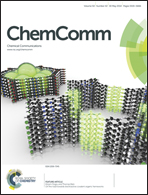Conversion of 5-hydroxymethylfurfural to a cyclopentanone derivative by ring rearrangement over supported Au nanoparticles†
Abstract
Supported Au nanoparticles showed efficient catalytic performance for the ring rearrangement of 5-hydroxymethylfurfural (HMF) to a cyclopentanone derivative, 3-hydroxymethylcyclopentanone (HCPN), by taking advantage of the selective hydrogenation on Au nanoparticles and the Lewis acid catalysis of metal oxide supports. Among various metal oxide supported Au catalysts, the highest yield of HCPN was obtained by using Au/Nb2O5 (86% yield).


 Please wait while we load your content...
Please wait while we load your content...